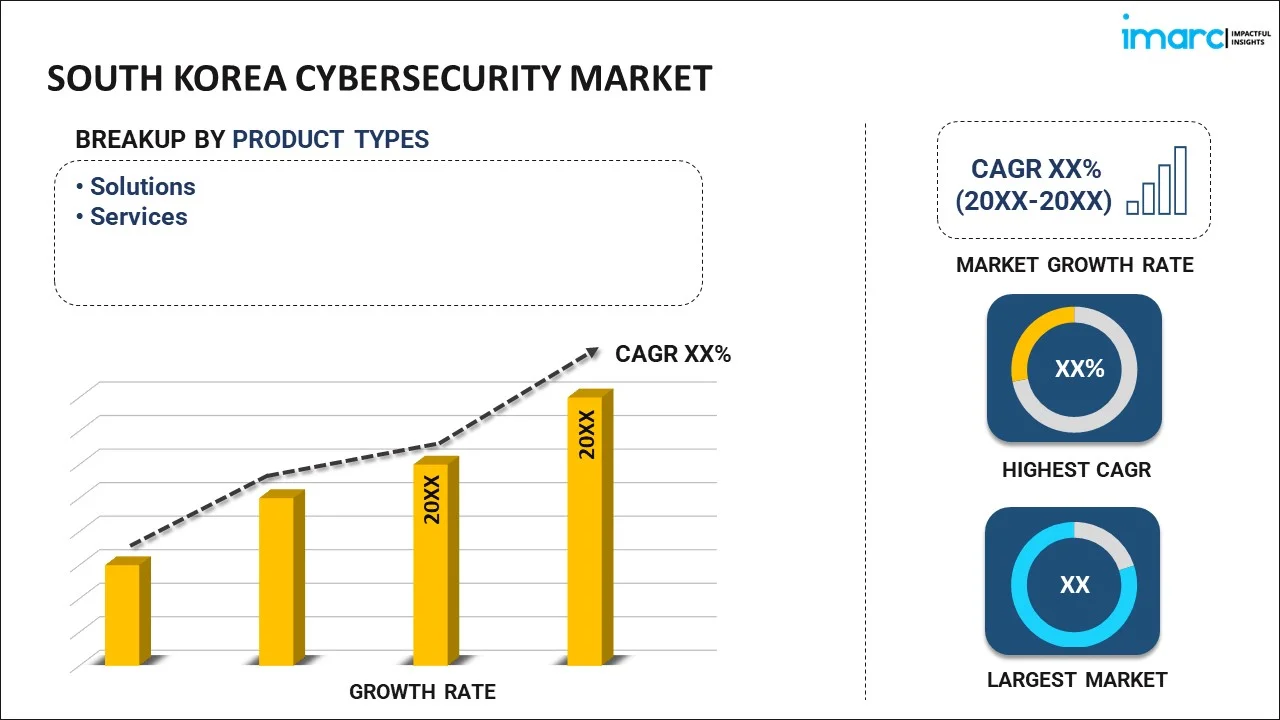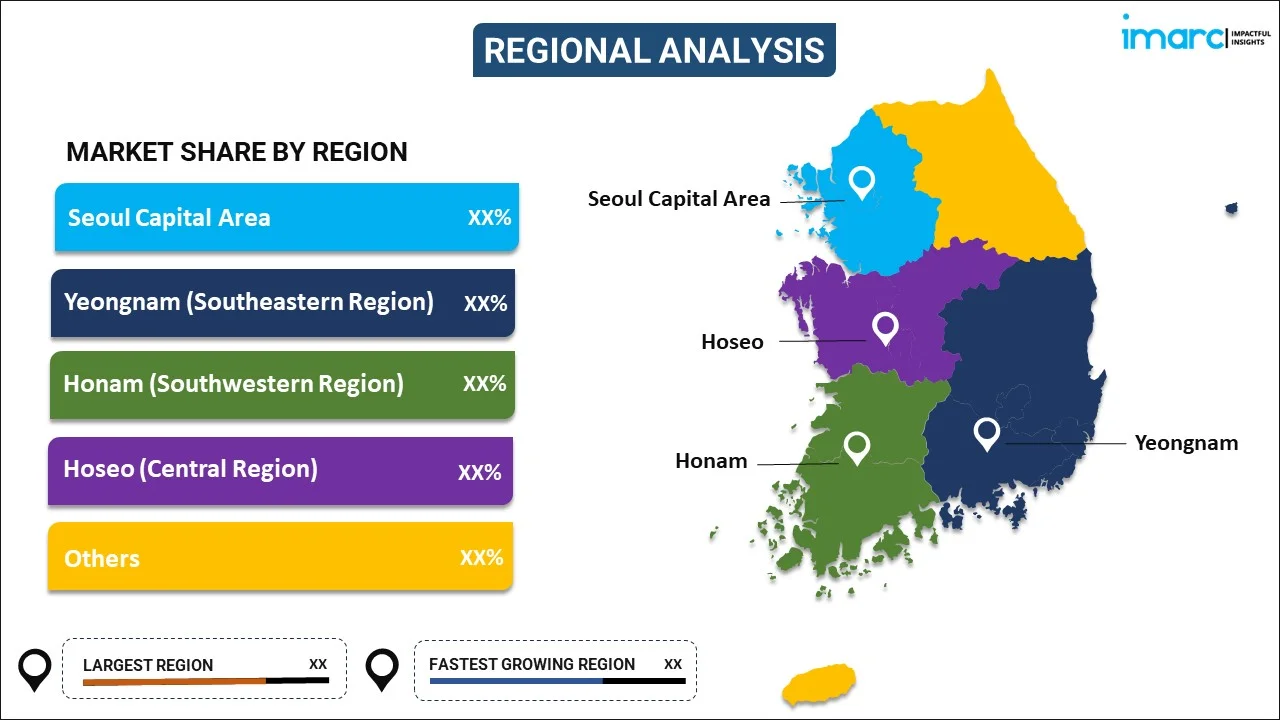
South Korea Cybersecurity Market Report by Product Type (Solutions, Services), Deployment Mode (Cloud-based, On-premises), End Use Industry (BFSI, Healthcare, Manufacturing, Aerospace and Defense, IT and Telecommunication, Retail, and Others), and Region 2024-2032
Market Overview:
South Korea cybersecurity market size is projected to exhibit a growth rate (CAGR) of 13.78% during 2024-2032. The increasing frequency and sophistication of cyberattacks, ongoing digital transformation such as the adoption of cloud computing and IoT, and the implementation of data privacy regulations represent some of the key factors driving the market.
|
Report Attribute
|
Key Statistics
|
|---|---|
|
Base Year
|
2023 |
|
Forecast Years
|
2024-2032
|
|
Historical Years
|
2018-2023
|
| Market Growth Rate (2024-2032) | 13.78% |
Cybersecurity, in its simplest terms, is the practice of protecting computer systems, networks, and digital data from theft, damage, unauthorized access, or any form of malicious attacks. It encompasses a wide range of technologies, processes, and practices designed to safeguard digital information and the systems that store or transmit it. It aims to prevent unauthorized individuals or entities from gaining access to sensitive data or systems. This involves setting up authentication methods like passwords, biometrics, and two-factor authentication (2FA) to ensure only authorized users can access the data. It also involves safeguarding data from theft or corruption. This may include encryption, data backup, and secure data storage practices to ensure data remains confidential and available when needed. As technology continues to advance, the field of cybersecurity remains dynamic and essential to protect our digital world from various cyber threats.
South Korea Cybersecurity Market Trends:
The increasing frequency and sophistication of cyberattacks in South Korea and globally are significant drivers of the cybersecurity market. As cybercriminals target businesses, government agencies, and individuals, the demand for cybersecurity solutions and services continues to grow. In addition, the South Korean government has taken proactive steps to enhance cybersecurity. Initiatives include investing in cybersecurity infrastructure, promoting cybersecurity education and awareness, and implementing regulations to enforce better security practices. These efforts drive market growth as organizations seek to comply with government requirements. Besides, South Korea's ongoing digital transformation, including the adoption of cloud computing, IoT (Internet of Things), and mobile technologies, creates new attack surfaces. Organizations are investing in cybersecurity solutions to protect their digital assets and data in this evolving landscape. Moreover, the COVID-19 pandemic accelerated remote work arrangements, increasing the need for secure remote access and collaboration tools. This trend has driven organizations to invest in cybersecurity solutions that ensure the security of remote workers and their devices. Furthermore, data privacy regulations such as the Personal Information Protection Act (PIPA) in South Korea and GDPR globally have made data protection a top priority for organizations. Complying with these regulations necessitates robust cybersecurity measures to safeguard sensitive information. Additionally, South Korean organizations are increasingly aware of the importance of securing their supply chains against cyber threats. Cybersecurity solutions that address supply chain vulnerabilities are in demand to ensure the integrity and security of products and services. Along with this, a shortage of skilled cybersecurity professionals is a challenge in South Korea. Organizations are investing in cybersecurity technologies to compensate for the shortage of qualified personnel, which is propelling the market.
South Korea Cybersecurity Market Segmentation:
IMARC Group provides an analysis of the key trends in each segment of the market, along with forecasts at the country level for 2024-2032. Our report has categorized the market based on product type, deployment mode, and end use industry.
Product Type Insights:

- Solutions
- Identity and Access Management
- Threat Detection and Prevention
- Security and Vulnerability Management
- DDoS Mitigation
- Security Information and Event Management
- Others
- Services
A detailed breakup and analysis of the market based on the product type have also been provided in the report. This includes solutions (identity and access management, threat detection and prevention, security and vulnerability management, DDoS mitigation, security information and event management, and others) and services.
Deployment Mode Insights:
- Cloud-based
- On-premises
The report has provided a detailed breakup and analysis of the market based on the deployment mode. This includes cloud-based and on-premises.
End Use Industry Insights:
- BFSI
- Healthcare
- Manufacturing
- Aerospace and Defense
- IT and Telecommunication
- Retail
- Others
A detailed breakup and analysis of the market based on the end use industry have also been provided in the report. This includes BFSI, healthcare, manufacturing, aerospace and defense, IT and telecommunication, retail, and others.
Regional Insights:

- Seoul Capital Area
- Yeongnam (Southeastern Region)
- Honam (Southwestern Region)
- Hoseo (Central Region)
- Others
The report has also provided a comprehensive analysis of all the major regional markets, which include Seoul Capital Area, Yeongnam (Southeastern Region), Honam (Southwestern Region), Hoseo (Central Region), and Others.
Competitive Landscape:
The market research report has also provided a comprehensive analysis of the competitive landscape in the market. Competitive analysis such as market structure, key player positioning, top winning strategies, competitive dashboard, and company evaluation quadrant has been covered in the report. Also, detailed profiles of all major companies have been provided.
South Korea Cybersecurity Market Report Coverage:
| Report Features | Details |
|---|---|
| Base Year of the Analysis | 2023 |
| Historical Period | 2018-2023 |
| Forecast Period | 2024-2032 |
| Units | US$ Million |
| Scope of the Report | Exploration of Historical Trends and Market Outlook, Industry Catalysts and Challenges, Segment-Wise Historical and Future Market Assessment:
|
| Product Types Covered |
|
| Deployment Modes Covered | Cloud-based, On-premises |
| End Use Industries Covered | BFSI, Healthcare, Manufacturing, Aerospace and Defense, IT and Telecommunication, Retail, Others |
| Regions Covered | Seoul Capital Area, Yeongnam (Southeastern Region), Honam (Southwestern Region), Hoseo (Central Region), Others |
| Customization Scope | 10% Free Customization |
| Report Price and Purchase Option | Single User License: US$ 3699 Five User License: US$ 4699 Corporate License: US$ 5699 |
| Post-Sale Analyst Support | 10-12 Weeks |
| Delivery Format | PDF and Excel through Email (We can also provide the editable version of the report in PPT/Word format on special request) |
Key Questions Answered in This Report:
- How has the South Korea cybersecurity market performed so far and how will it perform in the coming years?
- What has been the impact of COVID-19 on the South Korea cybersecurity market?
- What is the breakup of the South Korea cybersecurity market on the basis of product type?
- What is the breakup of the South Korea cybersecurity market on the basis of deployment mode?
- What is the breakup of the South Korea cybersecurity market on the basis of end use industry?
- What are the various stages in the value chain of the South Korea cybersecurity market?
- What are the key driving factors and challenges in the South Korea cybersecurity?
- What is the structure of the South Korea cybersecurity market and who are the key players?
- What is the degree of competition in the South Korea cybersecurity market?
Key Benefits for Stakeholders:
- IMARC’s industry report offers a comprehensive quantitative analysis of various market segments, historical and current market trends, market forecasts, and dynamics of the South Korea cybersecurity market from 2018-2032.
- The research report provides the latest information on the market drivers, challenges, and opportunities in the South Korea cybersecurity market.
- Porter's five forces analysis assist stakeholders in assessing the impact of new entrants, competitive rivalry, supplier power, buyer power, and the threat of substitution. It helps stakeholders to analyze the level of competition within the South Korea cybersecurity industry and its attractiveness.
- Competitive landscape allows stakeholders to understand their competitive environment and provides an insight into the current positions of key players in the market.
Need more help?
- Speak to our experienced analysts for insights on the current market scenarios.
- Include additional segments and countries to customize the report as per your requirement.
- Gain an unparalleled competitive advantage in your domain by understanding how to utilize the report and positively impacting your operations and revenue.
- For further assistance, please connect with our analysts.

 Inquire Before Buying
Inquire Before Buying
 Speak to an Analyst
Speak to an Analyst
 Request Brochure
Request Brochure
 Request Customization
Request Customization



.webp)




.webp)












